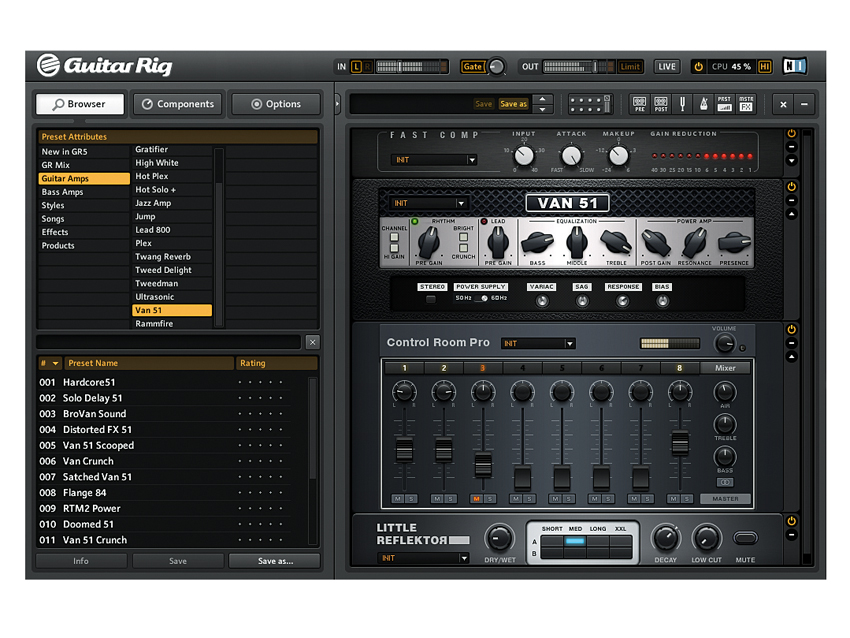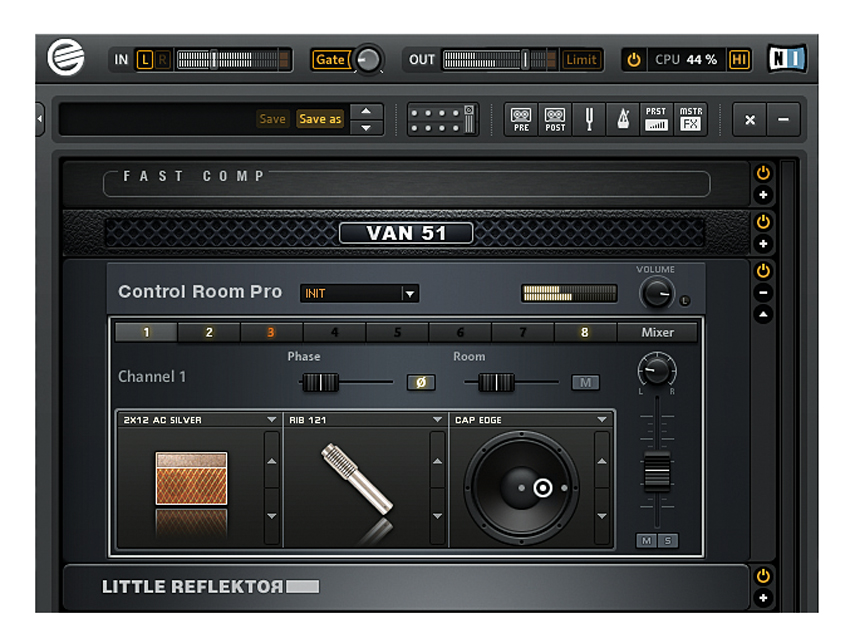MusicRadar Verdict
A smart upgrade for a feature-laden amp sim that remains a joy to use.
Pros
- +
Superb versatility and flexibility. All tonal bases covered. Comprehensive, usable presets. New amps are GR's best to date. Control Room Pro is excellent.
Cons
- -
Not as realistic as some sims. Control Room Pro can be CPU-heavy Some modules are so-so.
MusicRadar's got your back

Native Instruments Guitar Rig 5 Pro

Native Instruments Guitar Rig 5 Pro
Real guitar gear is known for its so-easy-a-guitarist-could-use-it simplicity, and yet virtual amp simulators continue to grow in complexity and capability.
Guitar Rig is easily one of the most feature-packed guitar/bass amp sims on the market, yet it remains one of the most user-friendly.
With this latest version, there are two new amp models, Control Room Pro for advanced mix-and-match cab/mic combos, six new effects, and a few crafty functional extras.
We're reviewing the software-only version here, but don't forget that there's the Kontrol edition too, bundled with the Rig Kontrol foot controller. The software comes as part of Komplete 8, too. It runs standalone or as a VST/AU/RTAS plug-in.
Initially, it might seem excessive that over a third of the GUI is given over to the (hideable) browser panel, but in our opinion, the most effective way of getting familiar with Guitar Rig is via the presets.
A lot of time has been put into these, and famous tones such as those of Satriani, Van Halen, Rammstein, ZZ Top, Hendrix, Led Zeppelin, and AC/DC are all on hand. Joining the pre-existing 15 amps are the Van 51, which is clearly a Peavey 5150 emulation, and Hot Solo +, which appears to be a Soldano imitation, judging by the logo - the knob style and labels hint at Soldano's Hot Rod 50 model.
We found that these two new amps can be used together to great effect. The Hot Solo + provides an authentic mid-boosted AC/DC-style rhythm crunch, while soaring, shredding solo tones are effortlessly had with the Van 51.
Surprisingly, there's little difference in tone when switching between the rhythm and lead channel of the Van 51 once both pre-gain knobs are set to give similar drive. This is quite unlike both the real hardware and Peavey's official 5150 emulation in their ReValver software.
Shoot-out!
Speaking of which, we took the opportunity to compare the 5150 emulations of Guitar Rig 5 Pro and Peavey's ReValver. By running the same drop-tuned, DI'ed guitar parts through both pieces of software, there was no doubt that the Peavey version could achieve tighter note definition and greater clarity out of the box - GR5 was slightly muddy in comparison.
However, this was quickly cured by inserting Guitar Rig's Skreamer overdrive unit before the amp. This is an emulation of the Ibanez Tube Screamer, which is often used in the real world to tighten the bottom end up in the same way.
GR5 has one up on most amp sims due to its Control Room Pro cab/mic system, which can be most useful in teasing just the right response from those palm-muted chugs.
In terms of its amp tones in general, Guitar Rig 5 Pro sounds very good, but it does fall slightly short when it comes to absolute authenticity, responsiveness and real-deal feel you'd get from a great valve amp/cab, which some other products pull off better.
Room for one more
Guitar Rig Pro 4 introduced Control Room, an eight-channel array of virtual cabs/mics that you could mix to create custom tones.
The mic selection was fixed, but expanding upon the concept is Control Room Pro, where you can choose cab, mic and mic position per channel, fade in a room mic and flip the phase, which can be a powerful tone-altering trick.
You can balance these eight (often vastly differing) sounds as you see fit via the module's mixer pane, with pan, level, solo and mute controls.
We found Control Room Pro really useful when using Guitar Rig 5 during the mix stage of a full production. We would first dial in the desired amount of gain and general frequency content using the amp sims.
From that point on, Control Room Pro became invaluable. By blending tones from differing cabs and mics, we could sculpt the overall timbre of the rhythm guitar tone, so that it would 'sit' in the mix most effectively, manipulating the timbre so that our guitars were not masking any of the other instruments frequency-wise.
Incidentally, Control Room Pro uses RedWirez impulse responses, which are some of the best we've tried, and having them accessible via such a friendly, flexible interface only enhances their usability.
Acting on impulse
Convolution reverb is now on Guitar Rig's effects menu, courtesy of the Little Reflektor. This offers eight impulse responses, all with decay and lowcut control.
We found it excellent, with the short plate, churches, cathedrals and big halls all sounding lush and highly useable, particularly on clean and country tones.
Added to this is the Vintage Verb effect, as well as a new classic compressor model, Fast Comp, both also very high quality.
The Resochord harmoniser is a little lacking, not quite having the desired effect when processing notes to sound like chords. This is due to the impact of unwanted artifacts, in the form of unusual 'whistles', tending to creep in.
We found the new Stereo Tune effect much more useable. This spreads the stereo image of a mono guitar to great effect, providing a much wider stereo image. It can also be used to fatten up a sound with more pronounced detuning, but we preferred it when used subtly.
The new FilterBank, an eight-band filter, is aimed at oddball guitar sounds, and it didn't help us much in our quest for a solid soloing tone. However, Guitar Rig is beloved of many a non-guitarist as a gnarly processor of synths and beats, and we suspect that this and Resochord will strike a particular chord with them.
The FilterBank does draw our attention, however, to the absence of a graphic equaliser with, say, 16 or 32 bands, which would be really useful for general tone-shaping.
GR5 adds sidechain inputs to compressors and some of the Modifiers modules, so a signal other than the guitar being processed can 'drive' the effect; for example, a bass drum can dictate when a compressor kicks in. Guitarists probably won't use this so much, but producers might.
Contain yourself
One undeniably great addition in GR5 is the Container module. Once you've created a chain of modules, you can wrap them in the Container and assign its macro controls (4, 8, 12 or 16) to parameters within the chain.
Each macro control can be a knob or a button, assignable to up to eight parameters (using a drag-and-drop system like NI's Massive), with adjustable ranges for each. It's a great system for simplifying control over complex rigs - great for live use.
In closing, it must be said that GR5 takes a huge leap in the right direction. Combine the sheer quantity of killer presets with the new amps, effects, and Control Room Pro, and you have a winning combination for guitarists, producers and sound designers alike.
Now listen to our Guitar Rig 5 Pro audio demos:
Almost Clean with 800 Clean
Hardcore 51 times four
Metalcore 51 with 800 Clean
NI GR5 Modern Gratifier times four
NI GR5 Skreaming Rammfire times four
Computer Music magazine is the world’s best selling publication dedicated solely to making great music with your Mac or PC computer. Each issue it brings its lucky readers the best in cutting-edge tutorials, need-to-know, expert software reviews and even all the tools you actually need to make great music today, courtesy of our legendary CM Plugin Suite.
“KIKI BOY 2025”: Frank Ocean appears to be teasing something... or other
“This is great. I knew I was getting to them! I’m so happy. It’s such a good feeling”: Spotify bites back at Kate Nash
“The included sample content is not only unique but sonically amazing, as it always was”: Spitfire Audio BBC Radiophonic Workshop review










